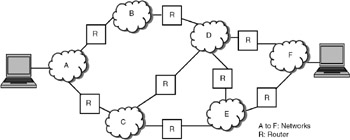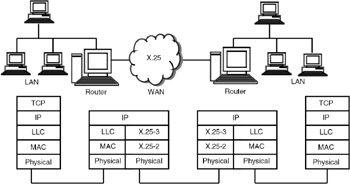Chapter 19: Internetworking
|
| < Day Day Up > |
|
To develop a LAN or WAN is straightforward, but how to network different networks is not. Each network has its own protocols, packet sizes and formats, speeds, addressing schemes, and so on. Internetworking or networking of networks is certainly a challenging task, and in this chapter we will discuss the issues involved in internetworking.
19.1 ISSUES IN INTERNETWORKING
Consider the simple case of connecting two networks as shown in Figure 19.1. Network A is a LAN based on Ethernet, and network B is a WAN based on X.25 protocols. It is not possible for a node on the LAN to transmit a packet that can be understood by a node on the WAN because of the following:
-
The addressing formats are different.
-
The packet sizes are different.
-
The medium access protocols are different.
-
The speeds of operation are different.
-
The protocols used for acknowledgements, flow control, error control, and so on are different.

Figure 19.1: Internetworking with a router.
To achieve connectivity among different networks, we need to solve the problem of interconnecting heterogeneous networks—this is known as internetwoking. Two different networks can be connected using a ‘router’ (or gateway) as shown in Figure 19.1. The connected network as a whole is referred to as an internet (small i) and each network as a subnetwork (or subnet) of the internet. The router operates at layer 3 of the OSI reference model. The router does the necessary protocol translation to make the two subnetworks talk to each other. Note that the router is the name given by equipment vendors; a router is referred to as a gateway in the documents of the Internet standards.
Interconnection of heterogeneous networks is called internetworking. A router or gateway is used to interconnect two networks.
| Note | The router that interconnects two networks does the necessary protocol conversion. The router operates at layer 3 of the OSI reference model. |
The functions of the router are as follows:
-
Accept the packet from the subnetwork A.
-
Translate the packet to a format understood by subnetwork B.
-
Transmit the packet to B.
Similarly, the packets from subnetwork B are transferred to subnetwork A after necessary translation or protocol conversion.
Now, consider the internet shown in Figure 19.2, where a number of subnetworks are connected together through routers. A node on subnetwork A has to send packets to a node on subnetwork F. For the packet to reach F, the packet has to traverse through other routers. A router's job is also to transfer the packet to an appropriate router so that the packet reaches the destination. To achieve this, each router has to keep a table, known as the routing table.

Figure 19.2: An internet.
This routing table decides to which router (or network) the packet has to be sent next.
| Note | Every router has a routing table. This routing table is used to route the packet to the next router on the network. The routing table is updated periodically to take care of changes in the topology of the network and the traffic on the network. |
The requirements of internetworking are:
-
Links between subnetworks.
-
Routing and delivery of packets.
-
Accounting to keep track of use of various networks and routers.
-
To be able to accommodate.
-
Different addressing schemes
-
Different packet sizes
-
Different network access mechanisms
-
Different timeouts
-
Different error recovery mechanisms
-
Different status report mechanisms
-
Different routing techniques
-
Connection-oriented and connectionless services
-
To achieve internetworking, the router is the most important element. To meet all the above requirements, the router has to perform protocol conversion. In addition, the following are required:
-
To take care of the differing protocols above the datalink layer, we need another layer of protocol that runs on each router and end system, known as the Internet Protocol (IP).
-
Because the addressing formats differ, we need a universal addressing scheme to address each machine uniquely. Each machine on the internet is given a unique address, known as an IP address.
-
For two end systems on the different networks to transfer packets irrespective of the underlying networks, we need another layer of communication software that has to run on each end system (or host). This protocol that handles the transportation of packets transparently is known as Transmission Control Protocol (TCP).
-
Above the TCP, we need to run different sets of protocols to provide different applications for the end users. We need a separate protocol for each application—for file transfer, electronic mail, remote login, web access; and so on.
These protocols form the TCP/IP protocol suite. The TCP/IP protocol suite is the heart of the world-wide Internet.
Internetworking is a complex task because different networks have different packet sizes, different address formats, different access protocols, different timeouts, and so on.
| Note | The TCP/IP protocol stack runs on each and every end system, whereas the IP protocol runs on every router on the Internet. |
Another issue in internetworking is how to connect two or more subnetworks when some subnetworks support connection-oriented service and some networks support connectionless service.
Connection-oriented internetworking: When two networks, both supporting connection-oriented service, have to be connected, it is called connection-oriented internetworking. In this case, the router that is used to connect the two subnetworks appears as a node to the subnetworks to which it is attached. A logical connection is established between the two networks, and this connection is a concatenation of the sequence of logical connections across the subnetworks.
When two networks, both supporting connection-oriented service, are interconnected, it is called connection-oriented internetworking.
Connectionless internetworking: Consider a situation in which a number of subnetworks are to be interconnected, but some subnetworks support connection-oriented service and some subnetworks support connectionless service. In this situation, the internet can provide datagram service. Each packet is treated independently and routed from the source node to the destination node via the routers and the networks. At each router, an independent routing decision is made. The advantage of this internetworking is that it provides a flexible service because underlying networks can be a mix of connectionless and connection-oriented services. Implementation using this approach is quite easy.
In connectionless internetworking, each packet is handled independently and routed from the source to the destination via routers.
| Note | Connectionless internetworking provides lots of flexibility because the networks can be a mix of both connection-oriented and connectionless services. The global Internet provides connectionless internetworking. |
The Internet Protocol (IP) and ISO/OSI Connectionless Network Protocol (CLNP) provide connectionless internetworking service (datagram service). However, note that the problems associated with the datagram service have to be taken care of. Packets may be lost, packets may be received with different delays as a result of which they will not be in sequence, and some packets may be received more than once. These problems are taken care of by the TCP layer.
Figure 19.3 illustrates the protocols that need to run on each node and the router in an internetworking scenario. Two LANs are interconnected through a WAN. Each node on the LAN runs the TCP/IP protocol suite (including the application layer software), and the WAN runs the protocols based on X.25 standards. The router has to run both the LAN and WAN protocols. In addition, it runs the IP software—it takes the packet from the LAN, converts it into packets that can be understood by the WAN protocols, and transmits on the WAN. Similarly, packets received from the other side are converted into a format that can be understood by the LAN. Figure 19.3 depicts the protocol stacks that run on the LAN nodes and the two routers.

Figure 19.3: Internetworking LANs through a WAN.
When a LAN is connected to a WAN, the router interconnecting the LAN and WAN has to run the protocol stacks of both LAN and WAN and do the necessary protocol translation.
|
| < Day Day Up > |
|
EAN: 2147483647
Pages: 313